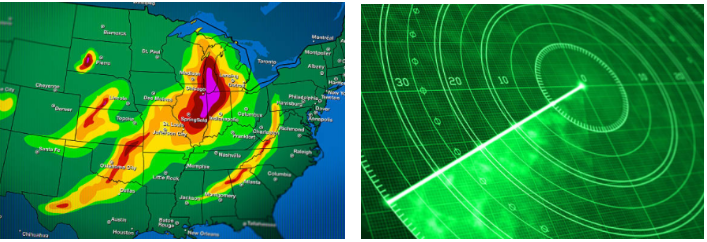Radar Technology Information
Everyone has heard of radar before, whether that be used for ships to help in navigation and collision avoidance or when watching your local TV news channel report on the weather with their Doppler Radar
equipment. Radar sensors are now even being used to help create self-driving cars! Well Gems Sensors uses similar radar technology in our Liquid Level sensors.
Radar’s Measuring Principle:
Radar
technology works by sending out short microwave signals toward the liquid via the sensor. The microwave signal then hits the liquid surface and bounces back toward the sensor. The sensor utilizes the time-of-flight principle which uses
the known speed of the microwave, and the time it took for the signal to return, divided by two (since it had to travel down to the liquid and then back up to the sensor) to determine the distance between the liquid level and the sensor. Since
most level is based on the height of the liquid, not the height of the non-liquid (air), the air height is subtracted from the total tank depth to determine the liquid level!

Advantages of Radar: There are many advantages of radar technology over other level sensing technologies. Through the air radar is a non-contact solution, whereas the liquid does not encounter any of the sensor's components. This
eliminates the need to worry about chemical compatibility between the sensor materials and the liquid. No more worrying about sourcing sensors comprised of expensive alloys or worrying about replacing them due to corrosion. In addition,
this non-contact is of course a no moving parts solution, which eliminates any mechanical failures you may have from a float-based sensor. Thus, no issues worrying about debris in the liquid that may foul up a contact-based sensor or more viscous
liquids coating the sensors causing failures.
Common Applications for Radar: Gems’ radar sensor can be used in countless non-contact level measurement applications of liquids and bulk solids. With the ability to measure in tanks as small as 1 foot and measure in tanks up
to 49 feet, the applications are limitless! Gems’ non-contact radar sensor has the capability to measure all kinds of liquids, even under high pressure and extreme temperatures, including solvents as well as aggressive liquids. In
addition, since this is a non-contact solution, Gems Radar level sensor is constructed of PVDF making it suitable for use in applications with strict hygiene requirements. Gems’ radar level transmitter can not only measure liquids but also bulk
solids with absolute reliability. And unlike ultrasonic technology, radar technology operates even if there is dust or high condensation.
Return to Gems’ Non-Contact Radar Level Sensor landing page for more information.
Further Information and Online Configurator >
 SEARCH OUR RESOURCE CENTER
SEARCH OUR RESOURCE CENTER

